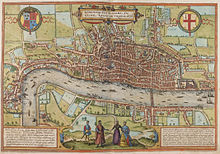

The "Copperplate" map of London is an early large-scale printed map of the City of London and its immediate environs, surveyed between 1553 and 1559, which survives only in part. It is the earliest true map of London (as opposed to panoramic views, such as those of Anton van den Wyngaerde). The original map was probably designed for hanging on a wall, and is believed to have measured approximately 3 feet 8 inches (112 cm) high by 7 feet 5 inches (226 cm) wide.[1] No copies of the printed map itself are known to have survived; but between 1962 and 1997 three of the original engraved copper printing-plates – from a probable total of 15 – were identified. Although only a fragmentary portion of the map is known, the three plates cover the greater part of the built-up heart of the City of London.
The map takes the form of a "bird's-flight view": that is to say, the street layout and other ground features are shown in plan, as if viewed directly from above; while buildings, people and other standing features are shown as if viewed from a great height to the south of the City, but without the foreshortening of more distant features that would be necessary for a true perspective view.
The map is clearly the source for the slightly smaller-scale and cruder "Woodcut" map, formerly attributed to Ralph Agas, which dates from shortly after 1561; and also, directly or indirectly, for the greatly reduced map of London included in Georg Braun and Frans Hogenberg's Civitates Orbis Terrarum, published in Cologne and Amsterdam in 1572. These two derivative maps allow the original extent and size of the Copperplate map to be estimated.
- ^ Marks 1964, p. 14